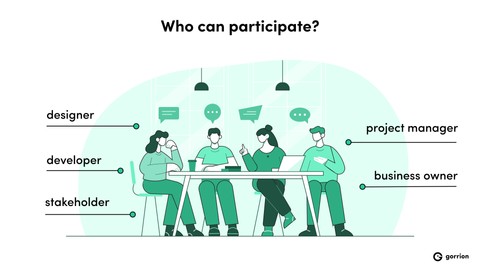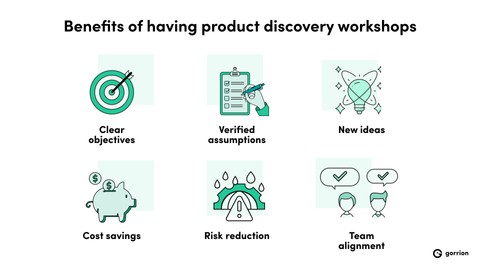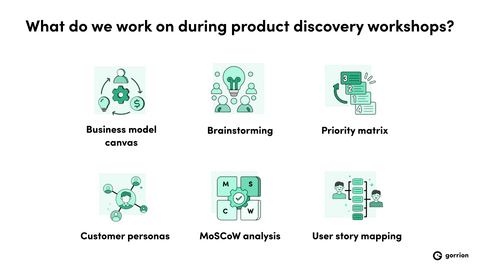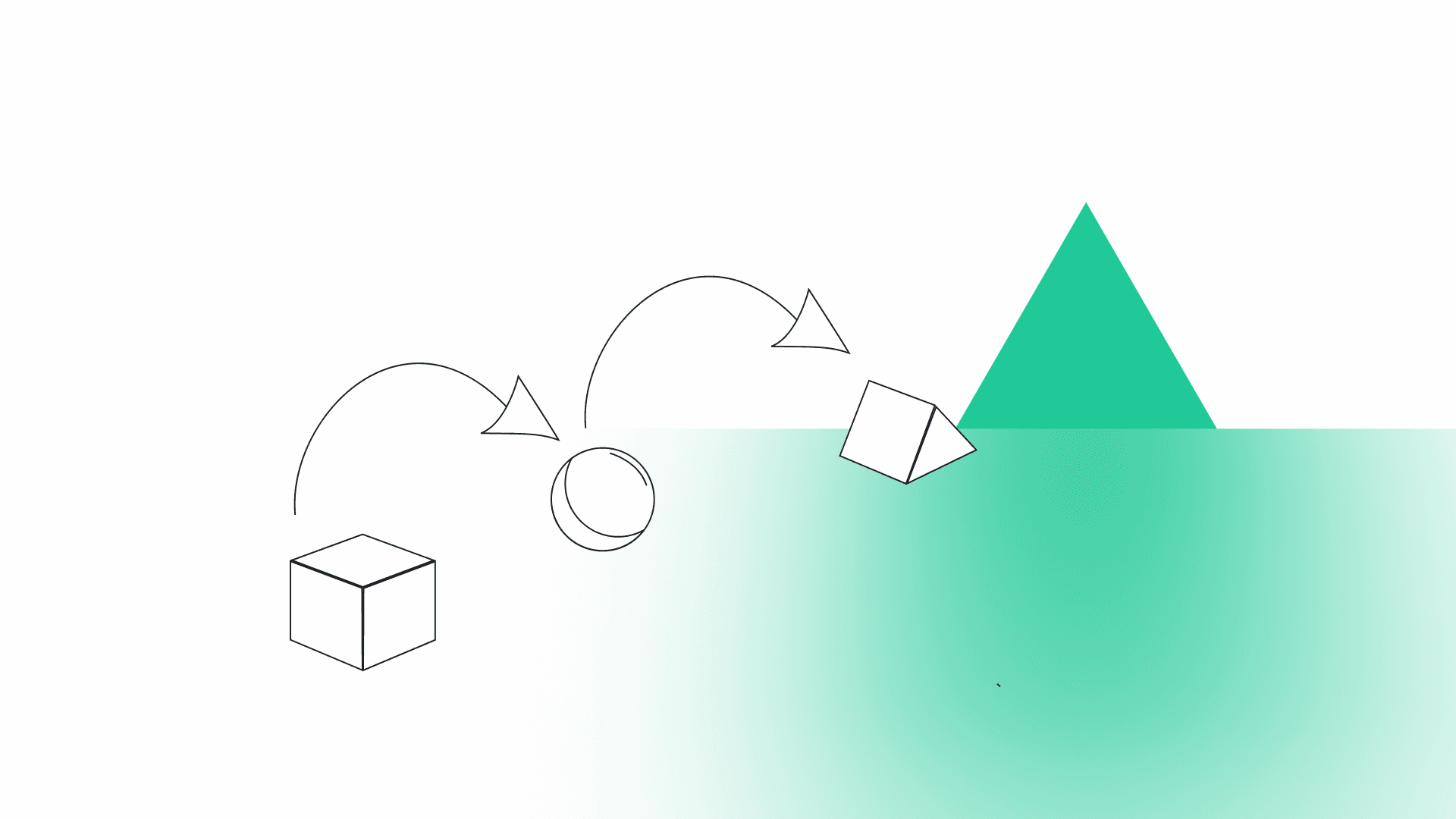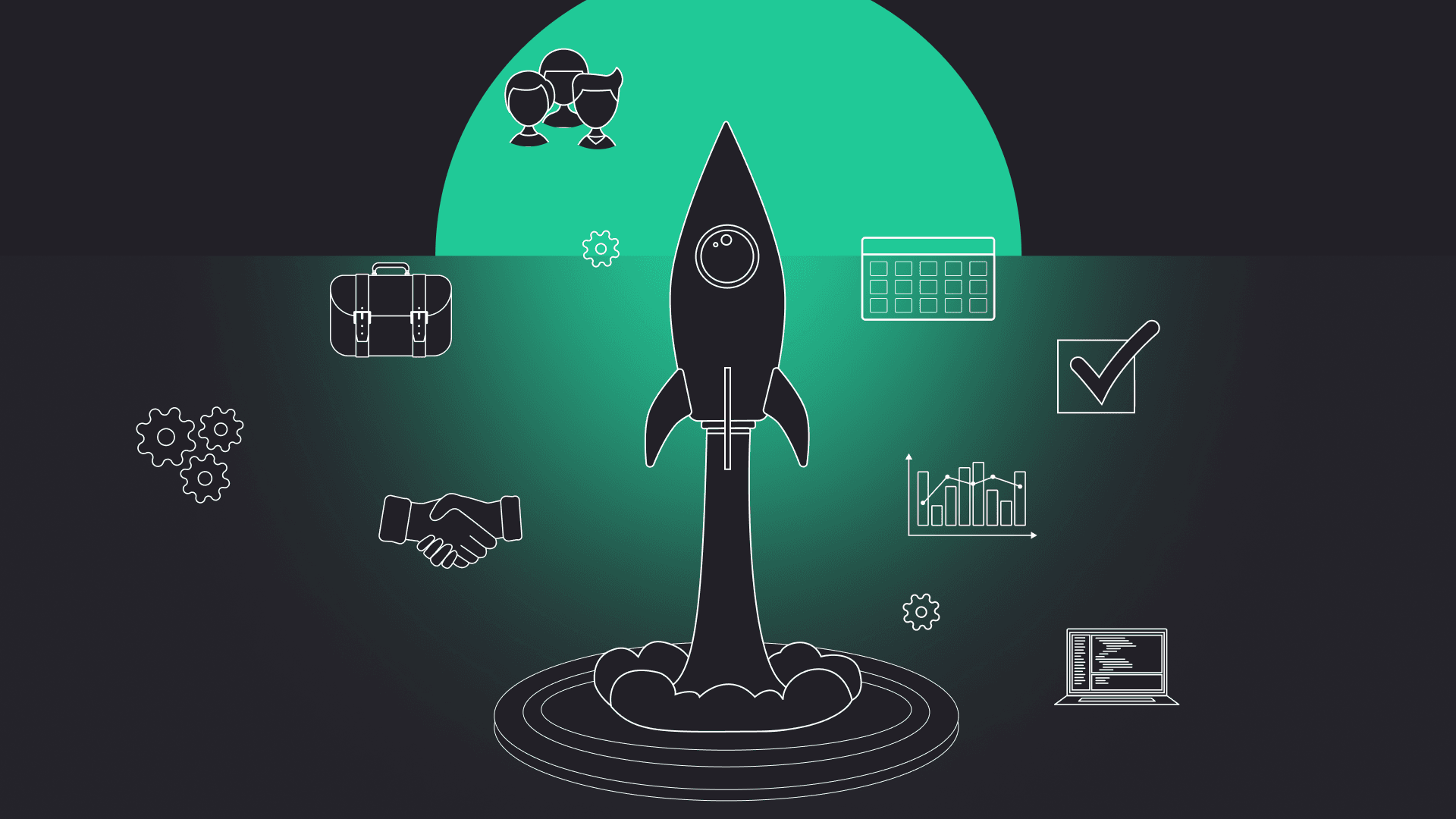


Our guideline for your next product discovery workshop (with free templates!)
What is a product discovery workshop and how to run it? How can it help you keep focus on your core strategy throughout the entire product development process? Is there a framework for it? Let’s see!
Software development is a complicated process that requires a lot of time and effort from the very beginning. There’s a client with business goals, there’s development teams, there’s market demand, and many more to reconcile.
The better we use the time for research and understanding of the goal at the beginning of the project, the better will the final outcome be. But how to do the research and be effective at it? This is where product discovery workshops come into play.
A quick definition of product discovery workshop
A product discovery workshop, also called product development workshop, is a meeting (or series of meetings) organized to help participants better understand and align on the idea for a product.
Who are the participants? The delivery team (including developers, designers, and the project manager), stakeholders (such as the business owner and executives, sales and marketing team, or subject matter experts from the company), and sometimes even potential customers or product users.
Through a series of exercises and discussions they explore, define, and refine new product ideas or features. The scope may include: coming up with ideas, defining the problem, researching users, prioritizing ideas, and sometimes even some live prototyping!
But why do you need a discovery workshop?
A product discovery workshop is a critical part of the entire software development process. Without it, you won’t know the project’s scale, the problems it’s facing and, more importantly, its target users and their needs. Conversely, having a discovery workshop helps the developers and designers get to know the client and vice versa. That’s why they are a mandatory part of the initial stages of product development lifecycle.
All in all, a product discovery workshop sets a strong foundation for the consecutive stages of the entire project, by helping define core functionalities, user personas, user story map, business needs, priorities, potential challenges, and a lot more. Because so much is uncovered there, a product discovery workshop also builds trust between the project team, the client, and key stakeholders.
Benefits of product discovery workshops
I’ve already touched briefly on why you should consider having workshops. But let me tell you a little more about the benefits – how they sets the ground for the entire product development process and help deliver on it successfully. I think you’ll see for yourself that it’s worth investing in this process!
Set objectives, clear priorities
During a discovery workshop, we talk with the client about the product, discuss functionalities, and decide which of these are critical. Together we also determine goals that need to be achieved. We’re thinking not only of the technical aspects but also business goals. This way, discovery workshops give us clear project objectives with established priorities and set milestones.
Plus, there’s a shared understanding within the group – everyone is on the same page which increases the chances that the project will be completed within the set deadline.
Verified assumptions
Sometimes clients come to us with a well thought-out project, while other times they only have an idea for the final product. One way or another, during the workshops, together we verify our assumptions by carrying out user research and checking market demand.
Do these assumptions correspond to user needs? What are the signs of product demand on the market? What does the target audience want? By defining user personas, writing user stories, user journey mapping, and other creative methods used in discovery workshops, we have a clear perspective on the matter. We can also identify customer pain points and prioritize the scope of work accordingly.
In short, we check these important aspects so that we can transform the product vision into an actual product that users will love.
Learn more about the process of market validation from How to validate your digital product idea?
New ideas
Throughout the discovery workshop, we perform technical, business, and creative analysis. We’re thinking about new interesting ideas for solutions and core functionalities. What’s more, we do market research and competitive analysis by checking similar apps and existing solutions.
This way, we can quickly generate a lot of ideas and potential solutions to address customer needs or business challenges. Then, we can discuss all and proceed with the best ones.
Cost savings
A discovery workshop is paradoxically also great for money-saving. I know what you may think: how is paying for and wasting my time on some extra steps “money saving?” The thing is, it’s not a waste of time!
Custom software development can get very expensive. But with workshops, the project team has a chance to understand the business and the product idea better and can adjust the roadmap to the project budget.
From the very beginning, we aim to develop software that doesn’t have superfluous features that our client would have to needlessly pay for. By analyzing which functionalities aren’t crucial for the product and then cutting them, we reduce the final bill and make the development process more cost-effective.
One of the solutions that we often propose and that helps you avoid unnecessary development costs is a minimum viable product (MVP) – a solution that combines simplicity and quality. Here, there’s no place for complexity or additional features. The MVP is all about user experience. Plus, it’s a great way to verify the market demand – a lot of the software that you use now (Facebook, anyone?) started with an MVP!
Learn about other ways to cut the software development costs while preserving product quality.
Alignment
During a product discovery workshop, you get to create a production plan (a roadmap, if you will) that allows you to sort all the information out. This includes the project timeline, functional specifications, core features, user tasks that are properly scoped and defined, and a lot more.
This alignment is equally important for everyone involved – the development team that now knows how to proceed, and the investor who can monitor and appraise the development progress.
Also, since the information is put in order and is all in one place, we can easily find what we’re looking for. Everyone can come back to it at any time during the production phase – not just the discovery workshop participants, but those who join the project later as well!
Risk reduction
A product discovery workshop is a great way to overcome potential challenges and get fresh perspectives. All the methods that we use during the workshop aim to prevent future errors. User personas, priority matrix, SWOT analysis – with these methods we find missing points and plan research to resolve them. For example, sometimes, our initial plan turns out to be costly, so we identify the problem and find an alternative.
And one extra: deeper connections!
Team work makes the dream work, right? Throughout the discovery workshop, the client and the development team work together on coming up with a common plan. There’s an opportunity for open communication and transparency in the group, which translates into a shared understanding of the goal.
The workshops also build trust and better relations. This, in turn, makes working together a lot easier down the line, as it sets the foundation for long-term collaboration.
How we do product discovery workshops at Gorrion
You can ask: is there a one-size-fits-all plan for a successful discovery workshop? The answer is no, there’s not. Or at least, there shouldn’t be. Every client needs to be treated individually as each project is different and unique.
Of course, there are frameworks for successful workshops, but they are just that – frameworks that shouldn’t be followed blindly. The right software development team keeps an open mind and moves within such framework to adjust to the project and the client’s needs.
Also, there’s no one ultimate “product discovery workshop template” and no defined number of workshops – it all depends on the scale and complexity of the project, as well as the number of participants.
So, if you’re considering hiring us to develop your next product, here’s a general outline of what you can expect from our product discovery workshops. If you’re looking to run your own workshops – read on to learn how the experts do it and get inspired! Also, be sure to head out to our community profile on Figma, where you will find templates for exercises we discuss below and many others – completely for free!
Free workshop templates
Preparations for discovery workshop
Since our workshops are tailor-made, before we can decide on a particular product discovery workshop agenda, we first meet our client for a so-called “kickoff call.” This is where you briefly describe your product idea, your journey, and what you expect us from us. It’s also an opportunity for you to ask questions and learn more about us!
Based on what we’ve gathered from that call, our team meets internally to discuss your idea, identify knowledge gaps, agree on our proposed approach, and come up with an agenda for the discovery workshop.
We’ll share that agenda with you. We’ll also outline what collaterals you can expect to be created in that meeting (more on those below!). Based on that you can decide if the workshops are worth your time – we certainly believe they are!
What happens during a discovery workshop?
It goes without saying that we come to the workshops prepared and armed with exercise boards! What exercises we choose for your product discovery workshop depends on a variety of factors. We mostly take into account the maturity of your business, i.e. how much “groundwork” you’ve already done. But we also consider the market and the competition, the complexity of your product, and some other factors.
Here are the exercises we reach for the most often.
Business model canvas
We usually start with a business model canvas which details the most important information about your company:
- what’s its value proposition and unique selling point;
- who’s the target audience, what are the market segments, and how to reach them;
- what are the business costs, available resources and potential revenue streams;
- and finally, who are the business partners.
A lot of our clients already know this information very well, as it’s foundational for any business, but it never hurts to have it written down. Especially since it’s tremendously useful in areas such as marketing and business development.
Customer personas
We also pay a lot of attention to customer personas. Again, you may have these already. If not, we’ll discuss, among other things:
- what they need and want,
- what motivates and frustrates them,
- what objections they may have to your product.
All this in the effort to better understand the main motivator behind all product development – the user.
Brainstorming
Next, we’ll move onto the product itself and brainstorm ideas. We’ll use creative exercises to discover all potential functionalities you might want to have in your application.
Some of them may be really far-fetched, but that’s all right! The goal here is to get creative and generate as many ideas as possible. Even if they won’t become a part of the MVP, you may still use them in future development!
At this point, we may also want to take a look at the competition, if any such exists, and see how our ideas stack up against theirs.
Prioritization
Then it’s time to choose which of these ideas we actually want to implement and prioritize them. For this we usually use two exercises: MoSCoW analysis and priority matrix.
The former categorizes tasks into “must haves,” “should haves,” “could haves,” and “won’t haves” (hence the acronym) and helps you trim down the list to what’s necessary here and now. The latter ranks ideas on two scales – the impact they will have on the product, and the effort it will take to implement them (which is why it’s also called an impact/effort matrix). Usually, you’ll want to implement high impact – low effort ideas first, obviously.
To learn more about these techniques, read our article about product backlog prioritization.
User flows
After that, we’ll do some user story mapping and discuss user flows, i.e. how we expect the customers to move through your app (e.g. what sequence they will go through to perform an action). We may even live-sketch some basic flows for the functionalities we’ve identified as the most important earlier.
If we don’t have time for this during our workshops, don’t worry! Our designers will prepare them for you later along with low-fidelity wireframes of the basic app views. To learn more about their creative process, read the answer to the question: What does a client get from designers?
What comes after the discovery workshop?
After an intense day of thinking, you can take a little breather. Meanwhile, our team will prepare a workshop summary for you. In it, we’ll share everything we’ve created during that meeting, so that you can reference it later. We’ll also share the wireframes mentioned earlier, so you can visualize how your app will look in the future. Lastly, we’ll share some estimates regarding the first phase of the project. These include the scope and project timeline, breakdown of the costs, and what team members we suggest should participate.
You may want to compare this proposal with what other companies have to offer. Regardless of whether you decide to move forward with us or not, the collaterals we’ve created during the workshops are yours. They will be extremely useful not just for project planning and development, but also for your sales and marketing teams.
If you do decide to proceed with us (spoiler alert: everyone does! 😉), the next phase of the project will probably be to create an MVP.
A special task force
It may happen that – instead or as a part of the workshops – we suggest an optional product design sprint. This happens especially when the idea is innovative and we want to see whether it’ll meet user needs.
A design sprint is a time-constrained and highly creative way of validating a concept. It’s goal is to reduce the risk that bringing a new solution to the market inherently carries even before we finish the discovery phase. Whether it’s a feature, service, or product, it helps us define project goals and check if the initial assumptions are accurate. It also allows us to do as much as possible in the shortest amount of time.
Here’s how a framework for a design sprint may look:
As you can see, even during a design sprint, our team always wants to work with you as our partner. All of that to make sure that the solutions we propose meet the requirements you put forward.
Tips for running a remote discovery workshop
Although we prefer meeting with our clients face to face, we can easily adapt to the circumstances, especially since we understand that remote is the preferred choice nowadays. Where there’s a need, there’s a way, and we’re pretty good at working remotely! Here are the tools that we use to make the entire process feel as close to working onsite as possible.
- Mentimeter – we use it during workshops for interactive presentations.
- Whimsical & Miro – tools for all of us to create flows and new ideas, analyze stakeholders, and vote on solutions.
- Slack – for all the team members and the client to discuss things daily. It’s a place to chat, address questions, share plans and put forward ideas.
- Slack calls and Google Meet – for discussing Sprint progress and priorities for the next week.
- ClickUp – thanks to this tool, we can plan and self-organize our work.
- Figma – a collaboration tool we use to share and talk about the project’s wireframes, interactive prototypes and their design. It’s also great during brainstorming sessions and building design systems. All in all, Figma is extremely helpful in the design process.
What’s great is that sometimes after our workshop, the client likes some of the tools we’ve used so much that they implement them at their company! It shows how helpful and useful they are. Thanks to these tools we can plan, design, chat, and make presentations from anywhere in the world.
Key takeaways
Building software, whether it’s a mobile application or a website, is never risk-free. But with product discovery workshops, you can manage the risk better. Carrying out a workshop during the discovery phase is a great way to start the development process. It’ll help you deliver the best solution and avoid unnecessary costs.
At Gorrion, we want to use all of our project experience to ensure that you’ll get the solution that meets your needs. Through our workshops and the delivered materials, we can make it happen – create a beautiful product that provides a seamless customer experience.
They are great for building trust since they provide a space for all the workshop participants to generate and put forward their ideas, give feedback on them and ultimately, hear each other’s opinions and insights. This, in turn, lays out the groundwork for a long-lasting collaboration.
Editor’s note: We’ve originally published this post in August 2020 and updated it in August 2023 for comprehensiveness.


Have a project in mind?
Let’s meet - book a free consultation and we’ll get back to you within 24 hrs.
At Gorrion, Dominika Stankiewicz manages content. Having spent a decade in marketing and communications, she’s the master of the written word and the guardian of style. On our blog she shares her experience in B2B product marketing to help SaaS companies plan and execute their go-to-market strategy. In her spare time, she reviews manuscripts for publishers and bakes cakes. She loves cats, books, and American football.
